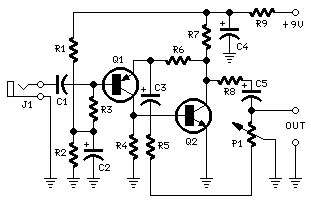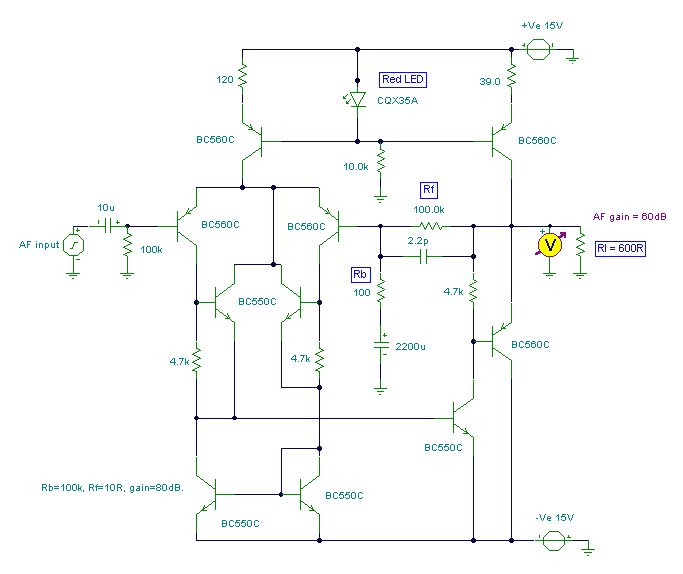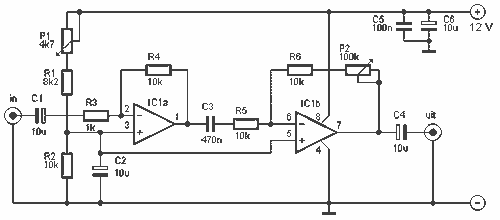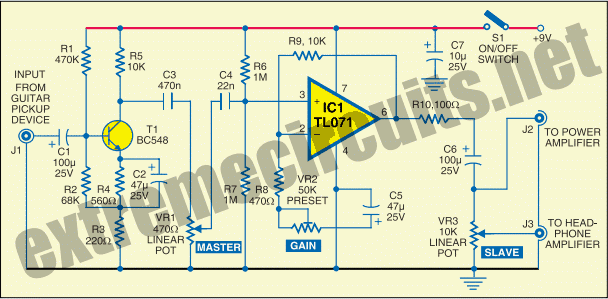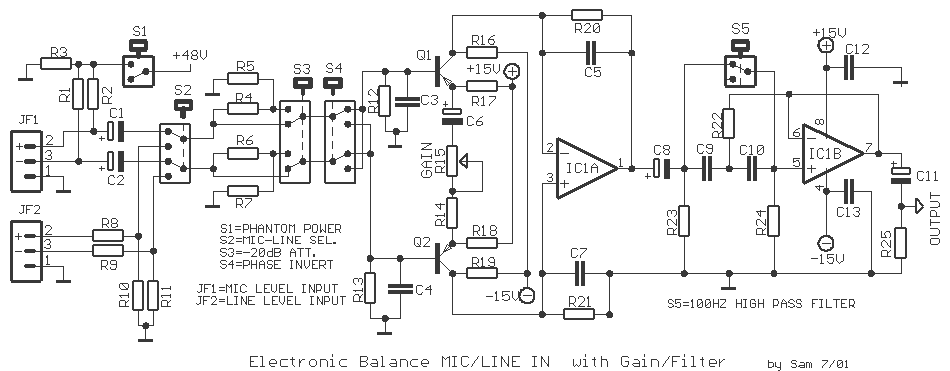
Moduler Preamplifier
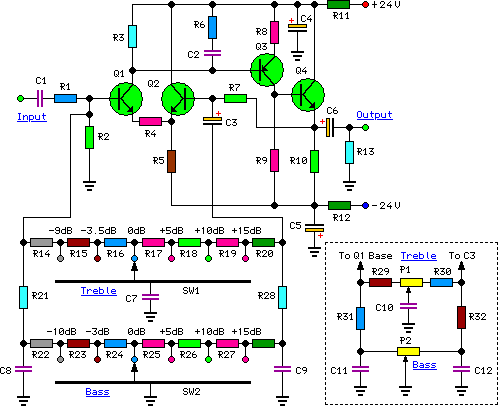
To complement the 60 Watt MOSFET audio amplifier, a high-quality preamplifier design was necessary. A discrete components topology utilizing ±24V supply rails was selected, with an emphasis on minimizing the transistor count while achieving low noise, very low distortion, and a high input overload margin. The modules forming this preamplifier can be utilized in various combinations and can drive different power amplifiers, provided that the following stages present a reasonably high input impedance (greater than 10 kΩ). If tone control functionality is not required, the preamplifier will consist solely of the main module. Its input will be connected to a changeover switch to allow multiple audio reproduction devices to be connected, such as a CD player, tuner, tape recorder, iPod, or MiniDisc. The total number and type of inputs can be chosen by the home constructor. The output of the main module will be connected to a 22 kΩ logarithmic potentiometer (dual gang if a stereo preamp is planned). The central and ground leads of this potentiometer must be connected to the power amplifier input. This module employs an unusual topology while maintaining the basic operational amplifier circuitry of the main module with some modifications in resistor values. A distinctive feature of this circuit is the use of six-way switches instead of the more common potentiometers; this allows for precise "tone flat" settings or preset dB steps in bass and treble boost or cut. Tone control switches also facilitate more accurate channel matching in a stereo configuration, avoiding the alignment inaccuracies often encountered with common ganged potentiometers. Six-way (two poles for stereo) rotary switches were chosen for this purpose due to their availability. This necessitated an unusual "asymmetrical" configuration with three positions for boost, one for flat, and two for cut, based on the practical use of tone controls for frequency boosting rather than cutting. The design includes 5 dB, 10 dB, and 15 dB bass boost options, along with -3 dB and -10 dB bass cut options. Treble boost is also set to 5 dB, 10 dB, and 15 dB, with treble cut set to -3.5 dB and -9 dB. Users wishing to implement common potentiometers for tone controls may utilize the circuit shown in the dashed box (bottom-right of the tone control module circuit diagram) to replace the switched controls. The tone control module is typically positioned after the main input module, with the volume control inserted between the tone control module output and the power amplifier input. Alternatively, the volume control may be placed between the main input module and the tone control module, depending on preference. Additionally, the positions of these two modules can be interchanged. The preamplifier requires a dual-rail ±24V, 50 mA DC power supply. This can be easily achieved using a 48V, 3VA center-tapped mains transformer, a 100V, 1A bridge rectifier, and a pair of 2200 µF, 50V smoothing capacitors. Two 24V IC regulators must be added: a 7824 (or 78L24) for the positive rail and a 7924 (or 79L24) for the negative rail. The diagram for this power supply is identical to that used in the headphone amplifier, but the voltages for the secondary winding of the transformer, smoothing capacitors, and IC regulators must be increased. Alternatively, the DC voltage can be derived directly from the DC supply rails of the power amplifier, provided that both 24V regulators are added. If this preamplifier is utilized as a standalone device, requiring a cable connection to the power amplifier, some form of output short-circuit protection is necessary to prevent shorts caused by incorrect plugging. The simplest method is to connect a 3.3 kΩ, 1/4W resistor in series with the output capacitor of the last module, which connects to the preamp main output socket.
The preamplifier circuit is designed to ensure high fidelity audio reproduction while maintaining flexibility for various audio sources. The discrete component topology allows for customization and optimization based on individual preferences or specific audio requirements. By utilizing high-quality components and a careful layout, the preamplifier minimizes noise and distortion, making it suitable for audiophiles and general users alike.
The changeover switch for input selection enables seamless transitions between different audio sources, enhancing user convenience. The choice of a logarithmic potentiometer for volume control ensures smooth adjustments across the audio range, while the use of rotary switches for tone control provides reliable and repeatable settings. The asymmetrical switch configuration reflects practical usage patterns, emphasizing bass boosting, which is often more desirable in everyday listening scenarios.
The power supply design is crucial for the stability and performance of the preamplifier. The use of a center-tapped transformer, along with appropriate rectification and smoothing, ensures that the preamplifier operates under optimal conditions. The inclusion of voltage regulators further enhances reliability, providing stable power across varying load conditions.
In terms of safety, the output short-circuit protection is a critical feature, safeguarding both the preamplifier and the connected power amplifier from potential damage due to user error. This design consideration highlights the importance of robustness in audio equipment, ensuring longevity and consistent performance.
Overall, this preamplifier design represents a well-thought-out approach to audio signal amplification, integrating flexibility, high performance, and user safety into a cohesive unit suitable for a variety of audio applications.To complement the 60 Watt MosFet Audio Amplifier a High Quality Preamplifier design was necessary. A discrete components topology, using and - 24V supply rails was chosen, keeping the transistor count to the minimum, but still allowing low noise, very low distortion and high input overload margin. Obviously, the modules forming this preamplifier c an be used in different combinations and drive different power amplifiers, provided the following stages present a reasonably high input impedance (i. e. higher than 10KOhm). If a Tone Control facility is not needed, the Preamplifier will be formed by the Main Module only. Its input will be connected to some sort of changeover switch, in order to allow several audio reproduction devices to be connected, e.
g. CD player, Tuner, Tape Recorder, iPod, MiniDisc etc. The total amount and type of inputs is left to the choice of the home constructor. The output of the Main Module will be connected to a 22K Log. potentiometer (dual gang if a stereo preamp was planned). The central and ground leads of this potentiometer must be connected to the power amplifier input. This Module employs an unusual topology, still maintaining the basic op-amp circuitry of the Main Module with a few changes in resistor values. A special feature of this circuit is the use of six ways switches instead of the more common potentiometers: in this way, precise "tone flat" setting, or preset dB steps in bass and treble boost or cut can be obtained.
Tone Control switches also allow a more precise channel matching when a stereo configuration is used, avoiding the frequent poor alignment accuracy presented by common ganged potentiometers. Six ways (two poles for stereo) rotary switches were chosen for this purpose as easily available. This dictated the unusual "asymmetrical" configuration of three positions for boost, one for flat and two for cut.
This choice was based on the fact that tone controls are used in practice more for frequency boosting than for cutting purposes. In any case, 5dB 10dB and 15dB of bass boost and -3dB and -10dB of bass cut were provided. Treble boost was also set to 5dB 10dB and 15dB and treble cut to -3. 5dB and -9dB. Those wishing to use common potentiometers in the usual way for Tone Controls may use the circuit shown enclosed in the dashed box (bottom-right of the Tone Control Module circuit diagram) to replace switched controls.
The Tone Control Module should usually be placed after the Main Input Module, and the volume control inserted between the Tone Control Module output and the power amplifier input. Alternatively, the volume control can also be placed between Main Input Module and Tone Control Module, at will.
Furthermore, the position of these two modules can be also interchanged. The preamplifier must be feed by a dual-rail, 24 and -24V 50mA dc power supply. This is easily achieved by using a 48V 3VA center-tapped mains transformer, a 100V 1A bridge rectifier and a couple of 2200 F 50V smoothing capacitors. To these components two 24V IC regulators must be added: a 7824 (or 78L24) for the positive rail and a 7924 (or 79L24) for the negative one.
The diagram of such a power supply is the same of that used in the Headphone Amplifier, but the voltages of the secondary winding of the transformer, smoothing capacitors and IC regulators must be uprated. Alternatively, the dc voltage can be directly derived from the dc supply rails of the power amplifier, provided that both 24V regulators are added.
If this preamplifier is used as a separate, stand-alone device, thus requiring a cable connection to the power amplifier, some kind of output short-circuit protection is needed, due to possible shorts caused by incorrect plugging. The simplest solution is to wire a 3K3 1/4W resistor in series to the output capacitor of the last module (i.
e. the module having its output connected to the preamp main output socket). 🔗 External reference
The preamplifier circuit is designed to ensure high fidelity audio reproduction while maintaining flexibility for various audio sources. The discrete component topology allows for customization and optimization based on individual preferences or specific audio requirements. By utilizing high-quality components and a careful layout, the preamplifier minimizes noise and distortion, making it suitable for audiophiles and general users alike.
The changeover switch for input selection enables seamless transitions between different audio sources, enhancing user convenience. The choice of a logarithmic potentiometer for volume control ensures smooth adjustments across the audio range, while the use of rotary switches for tone control provides reliable and repeatable settings. The asymmetrical switch configuration reflects practical usage patterns, emphasizing bass boosting, which is often more desirable in everyday listening scenarios.
The power supply design is crucial for the stability and performance of the preamplifier. The use of a center-tapped transformer, along with appropriate rectification and smoothing, ensures that the preamplifier operates under optimal conditions. The inclusion of voltage regulators further enhances reliability, providing stable power across varying load conditions.
In terms of safety, the output short-circuit protection is a critical feature, safeguarding both the preamplifier and the connected power amplifier from potential damage due to user error. This design consideration highlights the importance of robustness in audio equipment, ensuring longevity and consistent performance.
Overall, this preamplifier design represents a well-thought-out approach to audio signal amplification, integrating flexibility, high performance, and user safety into a cohesive unit suitable for a variety of audio applications.To complement the 60 Watt MosFet Audio Amplifier a High Quality Preamplifier design was necessary. A discrete components topology, using and - 24V supply rails was chosen, keeping the transistor count to the minimum, but still allowing low noise, very low distortion and high input overload margin. Obviously, the modules forming this preamplifier c an be used in different combinations and drive different power amplifiers, provided the following stages present a reasonably high input impedance (i. e. higher than 10KOhm). If a Tone Control facility is not needed, the Preamplifier will be formed by the Main Module only. Its input will be connected to some sort of changeover switch, in order to allow several audio reproduction devices to be connected, e.
g. CD player, Tuner, Tape Recorder, iPod, MiniDisc etc. The total amount and type of inputs is left to the choice of the home constructor. The output of the Main Module will be connected to a 22K Log. potentiometer (dual gang if a stereo preamp was planned). The central and ground leads of this potentiometer must be connected to the power amplifier input. This Module employs an unusual topology, still maintaining the basic op-amp circuitry of the Main Module with a few changes in resistor values. A special feature of this circuit is the use of six ways switches instead of the more common potentiometers: in this way, precise "tone flat" setting, or preset dB steps in bass and treble boost or cut can be obtained.
Tone Control switches also allow a more precise channel matching when a stereo configuration is used, avoiding the frequent poor alignment accuracy presented by common ganged potentiometers. Six ways (two poles for stereo) rotary switches were chosen for this purpose as easily available. This dictated the unusual "asymmetrical" configuration of three positions for boost, one for flat and two for cut.
This choice was based on the fact that tone controls are used in practice more for frequency boosting than for cutting purposes. In any case, 5dB 10dB and 15dB of bass boost and -3dB and -10dB of bass cut were provided. Treble boost was also set to 5dB 10dB and 15dB and treble cut to -3. 5dB and -9dB. Those wishing to use common potentiometers in the usual way for Tone Controls may use the circuit shown enclosed in the dashed box (bottom-right of the Tone Control Module circuit diagram) to replace switched controls.
The Tone Control Module should usually be placed after the Main Input Module, and the volume control inserted between the Tone Control Module output and the power amplifier input. Alternatively, the volume control can also be placed between Main Input Module and Tone Control Module, at will.
Furthermore, the position of these two modules can be also interchanged. The preamplifier must be feed by a dual-rail, 24 and -24V 50mA dc power supply. This is easily achieved by using a 48V 3VA center-tapped mains transformer, a 100V 1A bridge rectifier and a couple of 2200 F 50V smoothing capacitors. To these components two 24V IC regulators must be added: a 7824 (or 78L24) for the positive rail and a 7924 (or 79L24) for the negative one.
The diagram of such a power supply is the same of that used in the Headphone Amplifier, but the voltages of the secondary winding of the transformer, smoothing capacitors and IC regulators must be uprated. Alternatively, the dc voltage can be directly derived from the dc supply rails of the power amplifier, provided that both 24V regulators are added.
If this preamplifier is used as a separate, stand-alone device, thus requiring a cable connection to the power amplifier, some kind of output short-circuit protection is needed, due to possible shorts caused by incorrect plugging. The simplest solution is to wire a 3K3 1/4W resistor in series to the output capacitor of the last module (i.
e. the module having its output connected to the preamp main output socket). 🔗 External reference
